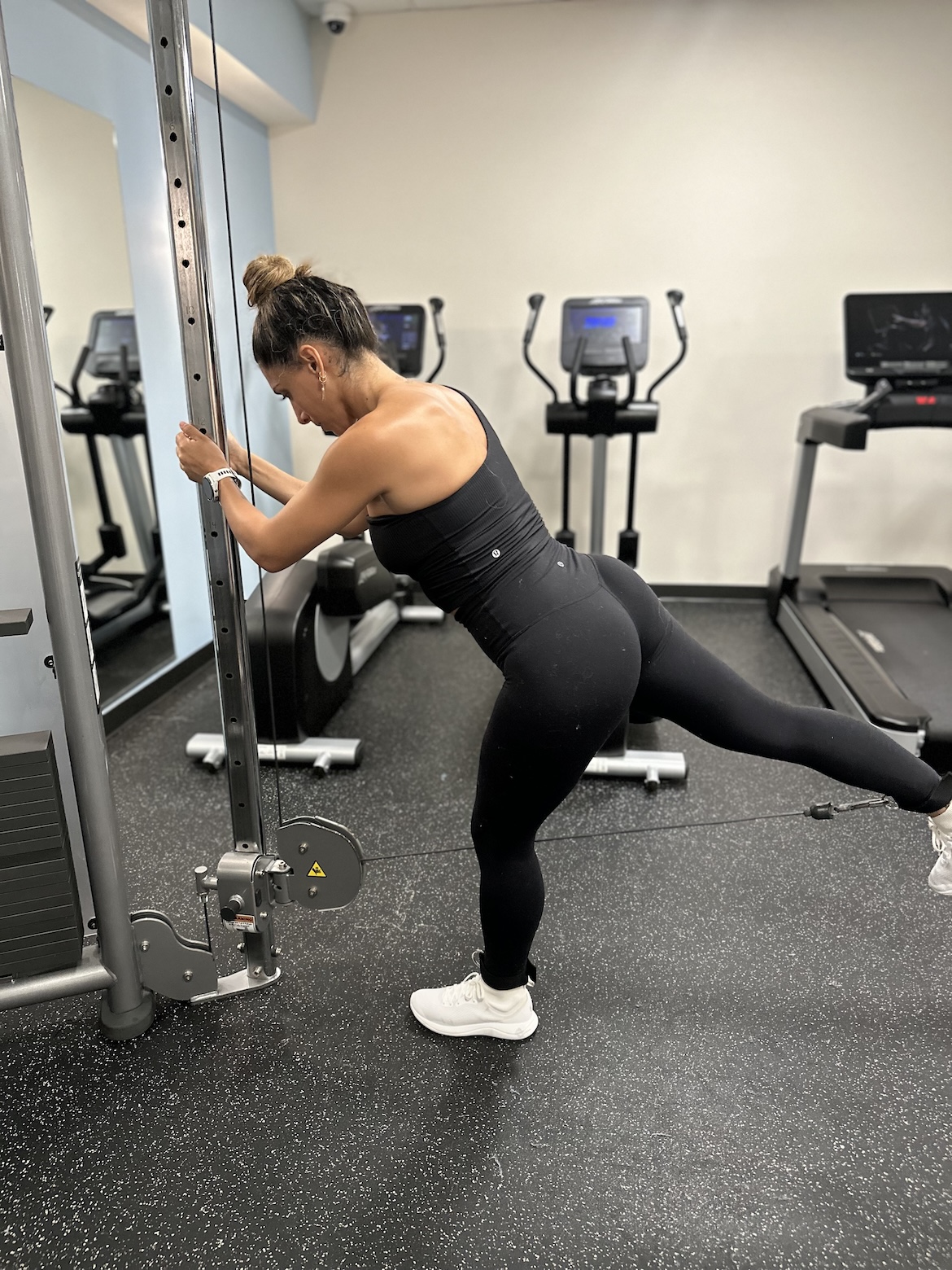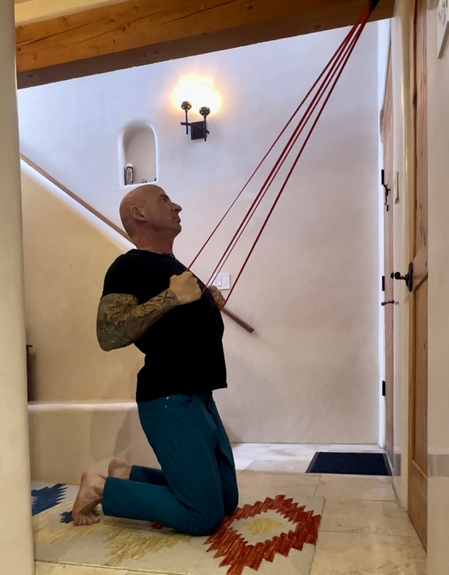Grabbing a barbell or a pair of dumbbells may be your go-to for glutes day, but you shouldn’t shy away from the cable machine when you’re trying to build a stronger backside.
Your glutes consist of three main muscles: the gluteus maximus (the largest of the group), gluteus medius, and gluteus minimus, says Or Artzi, CPT, NASM-certified personal trainer and Equinox group fitness instructor. “Using the cable machine can target all three parts from different angles for more balanced muscle development,” Artzi says.
Plus, the cable machine comes with a few extra perks that might just be the golden ticket to perking up your behind.
Below, Artzi shares some of the best cable machine glutes exercises to build a strong booty. Add these moves to complement your tried-and-true compound glutes exercises (like hip thrusts, sumo squats, and deadlifts) for a peach emoji-inspired backside.
The benefits of using a cable machine for glutes workouts
Incorporating cable machine exercises into your next leg-day routine complements other compound movements. Plus, it helps boost glutes activation, and provides a safe yet effective way to train for growth and strength, Artzi says. Here are five reasons to give the cable machine a shot.
1. It offers constant tension
When you’re working out with free weights, you’ll notice that you only feel tension at either the top or bottom of a movement. However, “the cable machine provides continuous resistance throughout the entire range of motion,” Artzi says. That constant tension helps maximize muscle activation, which translates to bigger glutes gains.
2. It’s user-friendly
The cable machine functions on a controlled path, so you won’t have to worry about dropping a weight on your toe or losing your balance during an exercise. That makes the cable machine extra great for beginners or people who are just getting back into lifting after a break.
But the cable machine is also excellent for advanced lifters looking to up the ante on their glutes. “The weight stack on a cable machine is easily adjustable, making it suitable for both beginners and advanced users to gradually increase resistance as strength improves,” Artzi says.
3. You can target your glutes from multiple angles
Cable machines have a wider range of motion than machines, according to a small 2017 study in the Journal of Strength and Conditioning Research. That means they provide you with a multitude of ways to move, depending on where you set the pulley. More variety means you can target the glutes from different angles for balanced muscle development, Artzi says.
4. You’ll have better stability
With free weights, you’re relying on gravity and momentum to move your muscles. On the other hand, “cable exercises require core and stabilizer muscle engagement, which helps improve balance and coordination while strengthening the glutes,” Artzi says.
Not only that, but cable exercises also often focus on unilateral (one-leg-at-a-time) movements, which help correct muscle imbalances, Artzi says.
5. It’s less harsh on your joints
Cable exercises are gentler on the joints compared to heavy barbell lifts. That’s because, again, they take gravity out of the equation. Still, “cable exercises allow for effective glutes training without adding unnecessary stress to the body,” Artzi says.
That makes cable exercises ideal for people with knee or lower back issues, or just anyone looking to add more low-impact exercises to their fitness routine.
“Using the cable machine can target all three parts from different angles for more balanced muscle development.” —Or Artzi, CPT
The best cable machine glutes exercises
Artzi loves adding these exercises as a spicy leg-day finisher. Just make sure to perfect your form with each, and continuously increase the weight or resistance over time to challenge your muscles and stimulate growth.
1. Cable glutes kickback
Photo: Or Artzi, CPT
Attach an ankle strap to the low pulley of the cable machine.
Stand facing the machine with the strap on your right ankle.
Holding onto the cable machine for balance, extend your right leg straight back, squeezing your glutes at the top. Make sure to avoid hyperextending at your lower back.
Then return to the starting position.
Repeat.
2. Cable pull-through
Photo: Or Artzi, CPT
Attach a rope handle to the low pulley of the cable machine.
Stand facing away from the machine with the rope between your legs.
Hinge at your hips, while keeping your back neutral.
Let the rope pull your arms through your legs, then thrust your hips forward to stand tall, engaging the glutes.
Repeat.
3. Cable Zercher squat
Photo: Or Artzi, CPT
Attach a straight bar to the low pulley of the cable machine.
Bend your arms and place the cable bar in the crease of your elbows with your palms facing upward.
Keep your forearms in a vertical position with your fists clenched, holding the bar securely in place tight to your body.
Stand with your feet shoulder-width apart, hold the handle, and perform a squat by pushing your hips back and bending your knees like you’re going to sit in a chair. Lower down as far as comfortable, or until your thighs are parallel with the floor.
Push through your heels and engage your glutes to stand.
Repeat.
4. Cable Romanian deadlift
Photo: Or Artzi, CPT
Attach a straight bar or rope handle to the low pulley of the cable machine.
Stand over the cable with your feet shoulder-width apart and grip the handle with an overhand grip (palms facing down).
Bend your knees slightly and hinge at your hips while keeping your back flat. You should feel a stretch in your hamstrings.
Reach your hips back as far as you can without rounding your low back or your shoulders.
Engage your glutes and drive your hips forward to stand.
Repeat.
5. Cable Zercher curtsy lunge
Photo: Or Artzi, CPT
Attach a straight bar to the low pulley of the cable machine.
Bend your arms and place the cable bar in the crease of your elbows with your palms facing upward.
Keep your forearms in a vertical position with your fists clenched, holding the bar securely in place tight to your body.
Put your weight onto your left leg and step your right leg behind and across your body.
Bend both knees into a curtsy.
Engage your glutes to push back to standing.
Repeat.
6. Cable hip abduction
Photo: Or Artzi, CPT
Attach an ankle strap to the low pulley of the cable machine.
Stand sideways with the right side of your body facing the machine with the strap on your left ankle.
Lift your left leg out to the side as high as you can.
Return your left leg to the starting position with control.
Repeat.
7. Cable step-up
Photo: Or Artzi, CPT
Attach a straight bar or rope to the low pulley of the cable machine and stand in front of a bench or box.
Step onto the bench with your left leg while holding the cable for resistance.
Engaging your glutes, drive through your left heel to stand up on your left leg.
At the same time, drive your right knee up to hip height, so your right thigh is parallel to the ground.
Reverse the move, lowering your right foot to the floor with control. Step your left foot down to the floor next to your right.
Repeat all reps on one side before switching legs.
8. Cable deficit reverse lunge
Photo: Or Artzi, CPT
Attach a straight bar or a handle to the low pulley of the cable machine.
Stand on top of a box or bench with your feet shoulder-width apart. Hold onto the cable handle with an overhand grip (palms facing down).
Step back off the box with your right foot, landing on the ball of your foot.
Bend your right back knee in a lunge position, lowering yourself down until both knees are at a 90-degree angle (or as low as you can comfortably go).
Keep your trunk upright and your hips facing forward.
Push off with your right foot to step your right leg back to the starting position.
Repeat all reps on one side before switching legs.
“The weight stack on a cable machine is easily adjustable, making it suitable for both beginners and advanced users to gradually increase resistance as strength improves.” —Or Artzi, CPT
Tips for using the cable machine
If your goal is to get comfortable with your gym’s cable machine, don’t neglect a few best practices. Below, Artzi shares some of her top tips for beginners.
1. Start with light weights
Pick a lighter weight to start with, and make sure your form is good to help avoid injury, Artzi says. (FYI, starting with light weights is the M.O. with any workout you’ve never tried before.)
Then, you can gradually increase the resistance as you become more comfortable with the movement.
2. Focus on form
Mind-muscle connection is key to isolating your glutes—but to achieve that, you have to perfect your form.
To nail down your form, you’ll want to avoid using momentum to lift the weight, Artzi says. “Maintain proper posture by engaging your core and keep your spine neutral,” she says. Then, focus on slow, controlled reps to keep your glutes under tension for a longer period—remember, time under tension boosts muscle engagement and maximizes results.
3. Use ankle straps
Many cable machine glutes exercises, like cable kickbacks and hip abductions, require ankle straps. “Using ankle straps gives you better control and helps isolate the glutes more effectively,” Artzi says.
Many commercial gyms have ankle straps hanging by the cable machine or stored at the front desk (just ask one of the staff members!). But if your gym doesn’t have ’em, consider investing in a pair (like these on Amazon for $10) to stash in your gym bag.
4. Never skip a warmup
No, warmups aren’t a waste of time. Artzi says you should always do a dynamic warmup before using the cable machine.
This can look like bodyweight exercises, like squats or bridges, to prepare the body for the workout, Artzi says. You can also add resistance bands to your pre-workout routine.
A glutes-activation warmup can help you tune into that mind-muscle connection so that it’s a bit easier to activate your glutes during those heavy booty-building lifts.






